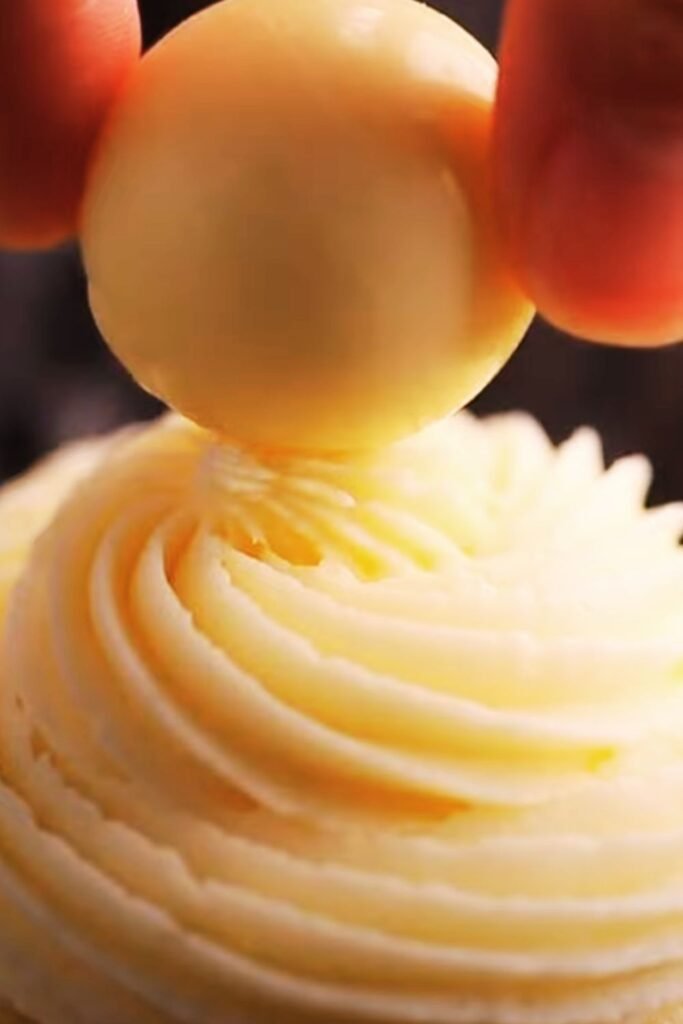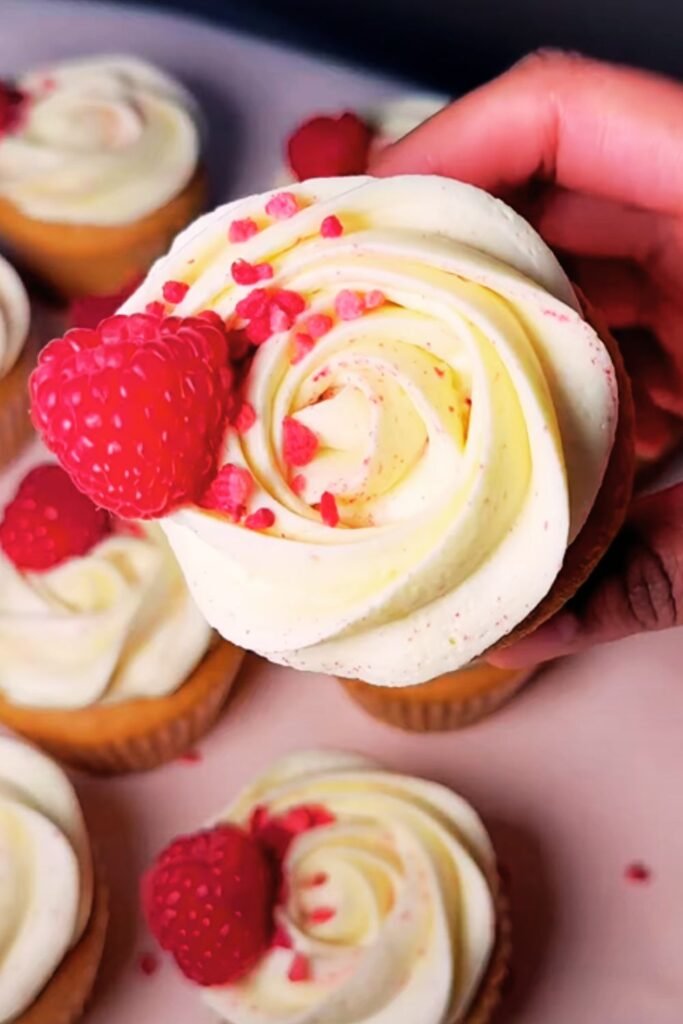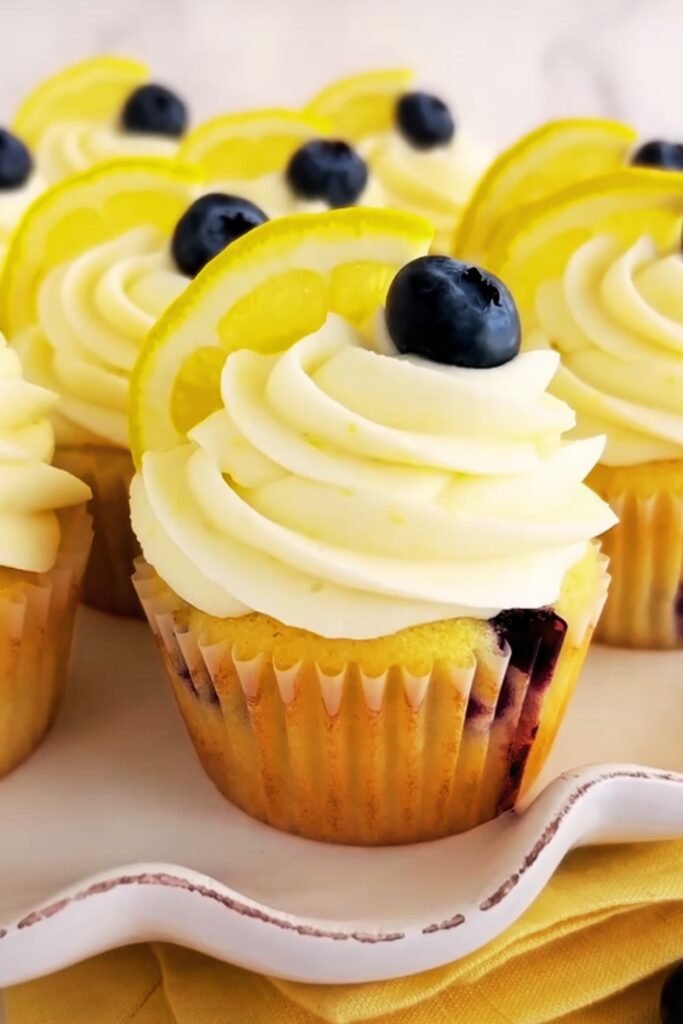There’s something absolutely magical about the combination of sweet white chocolate and tart blueberries that makes my heart skip a beat every time I take that first bite. I’ve been perfecting this white chocolate blueberry cupcake recipe for years, and I can honestly say it’s become one of my most requested treats among family and friends. The delicate vanilla notes from the white chocolate perfectly complement the burst of juicy blueberries, creating a dessert that’s both elegant and comforting.
When I first started experimenting with this recipe, I made countless mistakes – from overmixing the batter to using frozen blueberries that bled throughout the cupcakes. But through trial and error, I’ve discovered the secrets to creating consistently perfect white chocolate blueberry cupcakes that are moist, flavorful, and absolutely stunning to look at. These cupcakes strike the perfect balance between sophisticated flavors and homestyle comfort, making them ideal for everything from casual family dinners to special celebrations.
Understanding White Chocolate in Baking
White Chocolate: A confection made from cocoa butter, sugar, and milk solids, without cocoa powder. Quality white chocolate contains at least 20% cocoa butter and provides rich, creamy sweetness with subtle vanilla undertones.
Cocoa Butter Content: The percentage of cocoa butter in white chocolate affects both flavor and texture. Higher cocoa butter content (30-35%) creates smoother melting and richer taste, while lower content may result in waxy texture.
Tempering: The process of heating and cooling chocolate to specific temperatures to achieve proper crystallization, resulting in glossy finish and smooth texture when the chocolate sets.
Working with white chocolate requires a gentler touch than regular chocolate. I’ve learned that white chocolate burns much more easily due to its milk solids, so I always melt it using a double boiler or microwave at 50% power in 30-second intervals. The key is patience – rushing this process will result in seized chocolate that can’t be salvaged.
Blueberry Selection and Preparation
Fresh Blueberries: Plump, firm berries with deep blue color and natural bloom (whitish coating). Fresh berries provide the best texture and won’t bleed excessively into the batter.
Frozen Blueberries: While convenient, frozen berries release more moisture and can cause color bleeding. If using frozen, don’t thaw them before adding to the batter.
Berry Coating: Tossing blueberries in flour before folding into batter helps prevent them from sinking to the bottom during baking.
I prefer using fresh blueberries when they’re in season, typically from June through August. During off-season months, I opt for high-quality frozen berries, but I’ve developed a special technique to minimize bleeding. I coat the frozen berries in a tablespoon of flour and add them directly to the batter without thawing – this creates a barrier that reduces color transfer while maintaining the berries’ shape and flavor.

Essential Ingredients and Their Roles
| Ingredient | Quantity | Purpose | Substitution Notes |
|---|---|---|---|
| All-purpose flour | 2 cups | Structure and texture | Can substitute with cake flour (use 2¼ cups) |
| White chocolate | 6 oz | Primary flavor, richness | Use quality brands like Ghirardelli or Valrhona |
| Fresh blueberries | 1½ cups | Flavor, moisture, visual appeal | Frozen works but may cause bleeding |
| Unsalted butter | ½ cup | Fat content, flavor | European-style butter preferred |
| Granulated sugar | ¾ cup | Sweetness, structure | Caster sugar creates finer texture |
| Large eggs | 3 | Binding, leavening, richness | Room temperature for best incorporation |
| Buttermilk | ¾ cup | Acidity for tender crumb | Make substitute with milk + lemon juice |
| Vanilla extract | 2 tsp | Flavor enhancement | Pure vanilla only, never artificial |
| Baking powder | 2 tsp | Primary leavening agent | Ensure freshness for proper rise |
| Salt | ½ tsp | Flavor enhancement | Fine sea salt preferred |
The quality of your white chocolate cannot be overstated in this recipe. I’ve experimented with everything from budget grocery store brands to premium Belgian chocolates, and the difference is remarkable. Good white chocolate should list cocoa butter as the first or second ingredient, not palm oil or other substitutes. My personal favorites are Ghirardelli White Chocolate Baking Bars and Valrhona Ivoire, both of which melt beautifully and provide exceptional flavor.
Step-by-Step Baking Process
Preparation Phase (15 minutes)
Oven Setup: Preheat your oven to 350°F (175°C). This temperature ensures even baking without over-browning the delicate white chocolate.
Pan Preparation: Line a 12-cup muffin tin with paper liners. I prefer using high-quality liners that won’t stick to the cupcakes.
Ingredient Temperature: Bring eggs, buttermilk, and butter to room temperature. This step is crucial for proper emulsification and smooth batter.
White Chocolate Preparation (10 minutes)
I begin by chopping the white chocolate into small, uniform pieces. Smaller pieces melt more evenly and reduce the risk of burning. Using a double boiler, I melt the chocolate slowly, stirring constantly until smooth. If you don’t have a double boiler, place a heatproof bowl over a saucepan with about an inch of simmering water – just make sure the bottom of the bowl doesn’t touch the water.

Dry Ingredient Mixing (5 minutes)
In a large bowl, I whisk together flour, baking powder, and salt. This ensures even distribution of the leavening agents throughout the flour. I’ve found that sifting isn’t necessary for this recipe, but whisking thoroughly is essential.
Wet Ingredient Combination (10 minutes)
In a separate bowl, I cream the room-temperature butter with sugar until light and fluffy – this usually takes about 3-4 minutes with an electric mixer. The mixture should nearly double in volume and become pale in color. I then add eggs one at a time, beating well after each addition, followed by the vanilla extract and cooled melted white chocolate.
Batter Assembly (8 minutes)
Here’s where technique becomes critical. I add the dry ingredients in three additions, alternating with the buttermilk in two additions, beginning and ending with the flour mixture. I mix just until combined after each addition – overmixing develops gluten, resulting in tough cupcakes.
Berry Integration (5 minutes)
I coat the blueberries in a tablespoon of flour, then gently fold them into the batter using a rubber spatula. This coating prevents the berries from sinking and helps maintain their shape during baking.
Baking Process (20-25 minutes)
I divide the batter evenly among the prepared muffin cups, filling each about ⅔ full. This allows room for the cupcakes to rise without overflowing. I bake for 20-25 minutes, until the tops are lightly golden and a toothpick inserted in the center comes out with just a few moist crumbs.
White Chocolate Cream Cheese Frosting
| Ingredient | Quantity | Temperature | Notes |
|---|---|---|---|
| Cream cheese | 8 oz | Room temperature | Full-fat only, low-fat doesn’t whip properly |
| Unsalted butter | ½ cup | Room temperature | European-style preferred |
| White chocolate | 4 oz | Melted and cooled | Same quality as used in cupcakes |
| Powdered sugar | 3-4 cups | Room temperature | Sift if lumpy |
| Heavy cream | 2-4 tbsp | Cold | Add gradually for desired consistency |
| Vanilla extract | 1 tsp | Room temperature | Pure vanilla only |
The frosting is where these cupcakes truly shine. I start by beating the room-temperature cream cheese until completely smooth – any lumps at this stage will remain in the final frosting. I then add the butter and beat until fluffy, followed by the cooled melted white chocolate. The powdered sugar goes in gradually, alternating with small amounts of heavy cream until I achieve the perfect piping consistency.

Troubleshooting Common Issues
Dense Cupcakes: Usually caused by overmixing the batter or using ingredients that are too cold. Mix just until ingredients are combined, and ensure all ingredients are at room temperature.
Sunken Centers: Often results from opening the oven door too early or having an oven temperature that’s too high initially then dropping. Avoid opening the oven for the first 15 minutes of baking.
Blueberry Bleeding: Occurs when berries are too juicy or frozen berries are used without proper coating. Always coat berries in flour and avoid overmixing once they’re added.
Grainy Frosting: Results from powdered sugar that wasn’t properly incorporated or cream cheese that was too cold. Beat the frosting longer and ensure all ingredients are at proper temperature.
Nutritional Information and Dietary Considerations
| Nutrient | Per Cupcake | Daily Value % |
|---|---|---|
| Calories | 385 | 19% |
| Total Fat | 16g | 25% |
| Saturated Fat | 10g | 50% |
| Cholesterol | 65mg | 22% |
| Sodium | 285mg | 12% |
| Total Carbs | 58g | 19% |
| Dietary Fiber | 2g | 8% |
| Sugars | 42g | – |
| Protein | 6g | 12% |
| Vitamin C | 8mg | 13% |
| Calcium | 95mg | 10% |
While these cupcakes are undeniably indulgent, the blueberries do provide antioxidants and vitamin C. I’ve experimented with healthier modifications over the years, including reducing sugar by up to 25% and substituting part of the all-purpose flour with whole wheat pastry flour. These modifications work well, though they do change the texture slightly.
Storage and Serving Suggestions
Room Temperature: Unfrosted cupcakes keep for 2-3 days in an airtight container. Frosted cupcakes should be consumed within 24 hours at room temperature.
Refrigeration: Frosted cupcakes can be refrigerated for up to 5 days. Bring to room temperature before serving for best texture and flavor.
Freezing: Unfrosted cupcakes freeze beautifully for up to 3 months. Wrap individually in plastic wrap, then place in freezer bags. Thaw at room temperature before frosting.
I love serving these cupcakes at afternoon tea parties, baby showers, and spring gatherings. They pair wonderfully with fresh fruit, particularly strawberries and raspberries. For a more elegant presentation, I sometimes garnish with fresh blueberries and a small white chocolate curl on top of the frosting.
Flavor Variations and Adaptations
Lemon White Chocolate Blueberry: Add the zest of two lemons to the batter and one lemon’s zest to the frosting for a bright citrus note.
Almond White Chocolate Blueberry: Replace vanilla extract with almond extract (use half the amount) for a subtle nutty flavor.
Lavender White Chocolate Blueberry: Steep 1 tablespoon dried culinary lavender in warm buttermilk for 10 minutes, then strain before using.
Mini Cupcake Version: Use a mini muffin tin and reduce baking time to 12-15 minutes. This recipe makes approximately 36 mini cupcakes.
I’ve found that these variations allow me to customize the cupcakes for different occasions and personal preferences. The lemon version is particularly popular during summer months, while the lavender variation creates an elegant dessert perfect for sophisticated gatherings.
Professional Tips for Perfect Results
After years of making these cupcakes, I’ve developed several techniques that consistently produce bakery-quality results. First, I always weigh my flour rather than using volume measurements – 240 grams of all-purpose flour gives more consistent results than “2 cups,” which can vary significantly depending on how the flour is measured.
Temperature control is another crucial factor. I use an oven thermometer to ensure my oven is actually at 350°F, as many home ovens run hot or cold. I also rotate my cupcakes halfway through baking to ensure even browning.
For the smoothest frosting possible, I’ve learned to let the cream cheese and butter sit at room temperature for at least two hours before beginning. If I’m short on time, I cut the butter into small pieces and let the cream cheese sit in its opened package – this speeds the warming process considerably.
Seasonal Considerations and Ingredient Sourcing
The beauty of this recipe lies in its adaptability to seasonal ingredient availability. During peak blueberry season (June through August), I exclusively use fresh, local berries. I’ve found that smaller wild blueberries often have more intense flavor than the larger cultivated varieties, though both work beautifully in this recipe.
In winter months, I rely on high-quality frozen blueberries. The key is finding berries that were individually quick frozen (IQF) rather than frozen in clumps. These maintain better texture and distribute more evenly throughout the batter.
White chocolate quality varies significantly between brands and price points. I’ve tested dozens of different white chocolates over the years, and consistently find that those with higher cocoa butter content (30% or more) produce superior results. Avoid “white baking chips” or “white morsels,” as these often contain stabilizers that affect melting properties.
Special Occasion Presentations
These cupcakes lend themselves beautifully to special occasion presentations. For weddings, I’ve created tower displays using different sized cupcakes, with the white chocolate blueberry as the featured flavor. The natural elegance of the white frosting and scattered blueberries creates a sophisticated look that photographs beautifully.
For children’s parties, I sometimes add a small amount of natural food coloring to create pastel-tinted frosting. Lavender and pale pink work particularly well with the blueberry theme. I’ve also created “garden party” presentations by garnishing with edible flowers like violas or pansies alongside the blueberries.
Cost Analysis and Budget Considerations
| Component | Cost per Batch | Cost per Cupcake |
|---|---|---|
| White chocolate (quality) | $4.50 | $0.38 |
| Fresh blueberries | $3.00 | $0.25 |
| Dairy products | $2.25 | $0.19 |
| Dry ingredients | $1.50 | $0.13 |
| Frosting ingredients | $3.75 | $0.31 |
| Total | $15.00 | $1.25 |
While these cupcakes are more expensive to make than basic vanilla or chocolate varieties, the cost per serving remains reasonable for a specialty dessert. I’ve found that buying white chocolate in bulk during sales and freezing blueberries when they’re in season helps reduce overall costs.
The investment in quality ingredients pays dividends in flavor and texture. I’ve made these cupcakes with budget alternatives, and while edible, they lack the depth of flavor and luxurious mouthfeel that makes this recipe special.
Q&A Section
Q: Can I make this recipe into a layer cake instead of cupcakes? I absolutely love this question because I get it so often! Yes, you can easily convert this recipe into two 9-inch round layer cakes. Simply divide the batter between two greased and floured cake pans and bake at 325°F for 25-30 minutes. The lower temperature prevents the edges from overbaking before the center is done.
Q: Why do my blueberries always sink to the bottom? This is probably the most common issue I see with this recipe. The key is coating your blueberries in flour before folding them in, and making sure your batter isn’t too thin. If you’re using frozen berries, don’t thaw them first – add them straight from the freezer after coating in flour.
Q: Can I use white chocolate chips instead of chopped white chocolate? While you can use white chocolate chips, I really don’t recommend it for this recipe. Chips are formulated to hold their shape during baking, which means they don’t melt as smoothly. The result is a less integrated chocolate flavor and sometimes grainy texture. Bar chocolate that you chop yourself melts much more evenly.
Q: How do I prevent my frosting from being too sweet? I completely understand this concern – white chocolate is naturally sweet, and adding powdered sugar can make it overwhelming. My solution is to add a pinch of salt to the frosting and sometimes a teaspoon of lemon juice. You can also increase the cream cheese ratio slightly, using 10 oz instead of 8 oz, which adds tanginess to balance the sweetness.
Q: Can I make these cupcakes dairy-free? Making these dairy-free requires several substitutions that I’ve tested extensively. Replace the butter with vegan butter (I prefer Earth Balance), use coconut cream instead of buttermilk (thin it with a bit of lemon juice), and find a good dairy-free white chocolate. The texture will be slightly different, but still delicious.
Q: Why do my cupcakes have a dense, heavy texture? Dense cupcakes usually result from overmixing the batter once the flour is added. I always tell people to mix just until you can’t see dry flour anymore – the batter should still look slightly lumpy. Also, make sure your baking powder is fresh (replace every 18 months) and that you’re measuring flour correctly by spooning it into the cup rather than scooping.
Q: How far in advance can I make these for a party? For best results, I recommend making the cupcakes themselves up to two days ahead and storing them unfrosted in airtight containers. The frosting can be made a day ahead and stored in the refrigerator – just let it come to room temperature and give it a quick whip before using. Assembled cupcakes are best consumed within 24 hours.
Q: Can I double this recipe? Absolutely! This recipe doubles beautifully. Just make sure you have a large enough mixing bowl and don’t try to bake all 24 cupcakes at once unless you have two oven racks with good air circulation. I usually bake in batches to ensure even results.
Q: What’s the best way to fill cupcake liners evenly? I use an ice cream scoop or large cookie scoop to portion the batter – this gives me perfectly uniform cupcakes every time. Fill each liner about ⅔ full, which allows room for rising without overflow. If you don’t have a scoop, a ¼ cup measuring cup works well too.
Q: Help! My white chocolate seized while melting. Can I save it? Unfortunately, seized white chocolate can’t be saved for this recipe because it won’t incorporate smoothly into the batter. Prevention is key – make sure no water gets into the chocolate, use low heat or the microwave at 50% power, and stir frequently. Always have a backup plan when working with white chocolate!